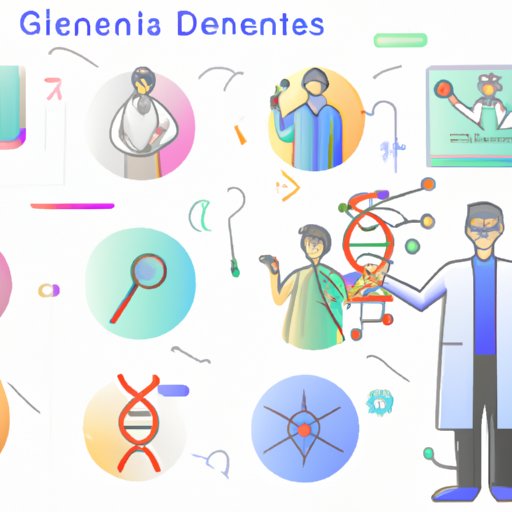
I. Introduction
Genetic diseases are inherited disorders that are caused by changes in our DNA. These diseases can range from mild to life-threatening and can impact people of all ages and ethnicities. Understanding the roots, causes, and treatments of genetic diseases is crucial for improving patient outcomes and developing preventative measures for future generations.
II. The Basics of Genetic Diseases: Understanding the Roots of Inherited Disorders
Genes are the building blocks of our DNA, which contain instructions for our bodies to function and grow. When there are alterations to our genetic code, diseases can arise. There are two types of genetic diseases: inherited and acquired. Inherited diseases are passed down from one or both parents and can be dominant or recessive. Acquired diseases occur due to environmental factors or lifestyle choices.
The inheritance of genetic diseases can follow a variety of patterns, depending on the specific condition and the genes involved. Some common inheritance patterns include autosomal recessive, autosomal dominant, X-linked dominant, and X-linked recessive. Understanding these patterns is essential for determining the risk of passing on a genetic disease to future generations.
III. Genetic Diseases: How Our DNA Can Hold the Answer to Life-Threatening Ailments
DNA mutations can cause genetic diseases to arise, which can range from mild to severe. For example, Cystic Fibrosis is a life-threatening genetic disease that affects the respiratory and digestive systems. An individual with Cystic Fibrosis inherits a mutated gene that results in thick mucus buildup in their lungs, making it difficult to breathe. Another example is Hemochromatosis, a genetic disorder where the body accumulates too much iron, leading to tissue damage.
Early detection of genetic diseases is crucial for patients with inherited disorders. Many genetic diseases can be detected before birth through prenatal screening, allowing parents to prepare for the child’s care. For adults, genetic testing can identify if someone is a carrier of a specific inherited disorder, which is crucial for family planning and potential treatments.
IV. From Sickle Cell Anemia to Cystic Fibrosis – What You Need to Know About Genetic Disorders
There are hundreds of genetic diseases that are known to exist. Some of the most common genetic diseases include Sickle Cell Anemia, Cystic Fibrosis, Down Syndrome, Huntington’s Disease, and Tay-Sachs Disease. Each genetic disease is unique and affects individuals differently.
The symptoms and progression of genetic diseases vary widely. Sickle Cell Anemia causes chronic pain, anemia, and organ damage, while Cystic Fibrosis results in difficulty breathing and digestive issues. There are various treatment options available, depending on the specific condition. Some treatments include medication, gene therapy, organ transplants, and lifestyle changes.
V. The Science Behind Genetic Diseases: Detecting, Treating, and Preventing Inherited Illnesses
There are several diagnostic tools available to detect genetic diseases. One of the most commonly used is genetic testing, where saliva or blood samples are analyzed to identify mutations in specific genes. Prenatal screening is also available to test for genetic diseases before birth.
The treatment options for genetic diseases vary widely and depend on the specific condition and the individual’s needs. For some individuals, lifestyle changes such as diet and exercise can significantly improve their quality of life. For others, medication, therapy, and organ transplants are viable options to manage symptoms.
Preventative measures for genetic diseases can include genetic counseling and family planning. Genetic counseling allows individuals who are at risk of inheriting a genetic disease to understand their options and potential outcomes. Family planning can help couples make informed decisions about having children and whether to pursue options such as adoption or in vitro fertilization.
VI. When Our Genes Go Wrong: A Closer Look at What Causes Genetic Disease and How We Can Fight Back
Genetic mutations can occur spontaneously or due to environmental factors such as radiation or toxins. These mutations can cause genetic diseases to arise, affecting an individual’s quality of life and lifespan.
While there is no cure for many genetic diseases, research is ongoing to find treatments and cures. Gene therapy is an emerging option that involves replacing or repairing genes to prevent or cure genetic diseases. There is also research into using CRISPR technology to edit out specific gene mutations that cause disease.
VII. Conclusion
Understanding genetic diseases is essential for improving patient outcomes and developing preventative measures for future generations. Genetic diseases can range from mild to life-threatening and can impact people of all ages and ethnicities. Early detection, individualized treatment plans, and preventative measures such as family planning can significantly improve the quality of life for individuals with genetic diseases.
For more information on genetic diseases and available resources, visit the National Institute of Health’s Genetic and Rare Diseases Information Center at https://rarediseases.info.nih.gov/.




